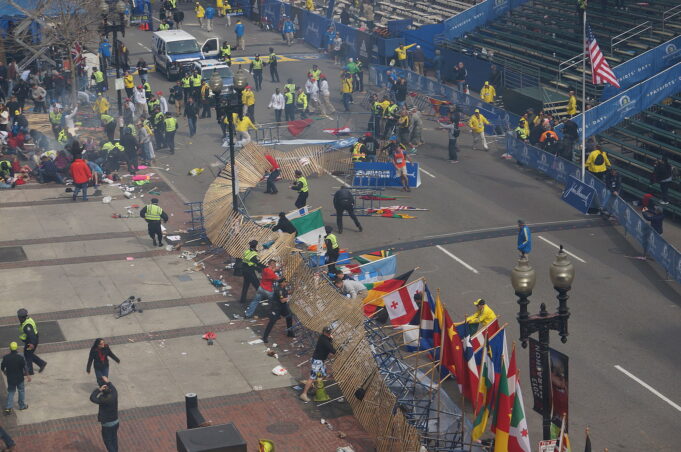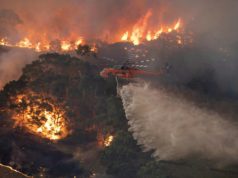Wikimedia Commons / CC-BY-SA-3.0 / GFDL
1 – Boston Marathon Bombing
On 15 April 2013, two homemade pressure-cooker bombs detonated 12 seconds near the finish line of the annual Boston Marathon. The bombs killed three people and injured several hundred more, including 16 who lost limbs.
Three days later, the FBI released images of two suspects, who were later identified as brothers Dzhokhar Tsarnaev and Tamerlan Tsarnaev, of Chechen Kyrgyzstani origin.
The brothers killed an MIT policeman, kidnapped a man in his car, and had a shootout with the police in nearby Watertown, during which two officers were severely injured, one of whom died a year later.
During the shootout, Tamerlan was shot several times, before his brother ran him over while escaping in the stolen car. Tamerlan died a short time later.
On April 19, a huge manhunt took place for Dzhokhar, with thousands of law enforcement officers searching a 20-block area of Watertown. Residents of the area were asked to stay indoors, while the transportation system, most businesses, and public places closed.
Around 6 pm that evening, a Watertown resident discovered Dzhokhar hiding in a boat in his backyard, suffering from wounds following the shootout.
Police took him into custody for questioning. Dzhokhar said the brothers were motivated by extremist Islamist beliefs and the wars in Iraq and Afghanistan.
Tsarnaev also said they had learned to build explosive devices from Inspire, an online magazine published by an al-Qaeda affiliate in Yemen. They had also intended to travel to New York City and bomb Times Square.
On 8 April 2015, he was convicted of 30 charges and was sentenced to death two months later.
On the second anniversary of the Bombings, Mayor Marty Walsh established April 15, the day of the bombings, as an official and permanent holiday called “One Boston Day”, dedicated to conducting random acts of kindness and helping others out.
2 – The Ghouta Chemical Weapons Attack in Syria Causes Global Outrage
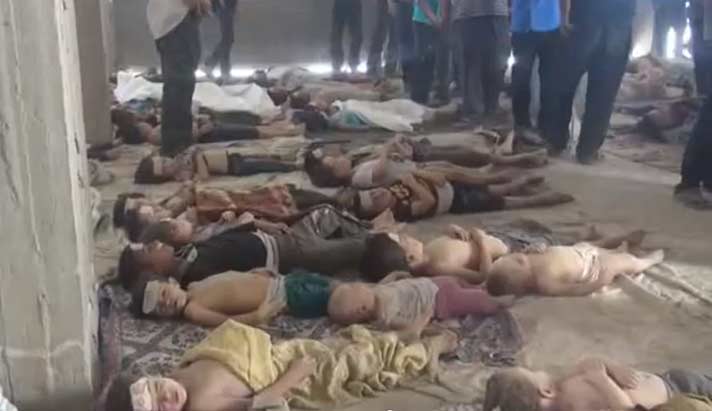
In the early hours of 21 August 2013, a chemical attack occurred in Ghouta, Syria during the Syrian Civil War. The attack was the deadliest use of chemical weapons since the Iran–Iraq War in the 1980s.
Two opposition-controlled areas in the suburbs of Damascus were struck by rockets containing the chemical agent sarin. The death toll estimates range from 281 to over 1,700.
United Nations inspectors, already in Syria to investigate another alleged chemical weapons attack, requested access to the sites in Ghouta and called for a ceasefire to allow inspectors to visit the area.
The Syrian Ba’athist government granted the UN’s request on 25 August, allowing inspectors to visit the sites on 28 and 29 August. The UN investigation team found clear and convincing evidence of the use of sarin delivered by surface-to-surface rockets.
The Syrian opposition, the Arab League, and the European Union each stated the attack was carried out by Syrian President Bashar al-Assad’s forces. The Syrian and Russian governments refuted this, calling the attack a false flag operation by the opposition.
On 6 September, the United States Senate filed a resolution to authorize the use of military force against the Syrian military.
This action was averted days later after the Syrian government accepted the US–Russian negotiated deal to turn over all of its chemical weapons stockpiles for destruction and declared its intention to join the Chemical Weapons Convention.
A 2014 UN Human Rights Council report found significant quantities of sarin had been used in a well-planned indiscriminate attack targeting civilian areas, causing mass casualties.
The evidence also indicated the perpetrators presumably had access to the chemical weapons stockpile of the Syrian military, as well as the necessary expertise and equipment to safely use chemical agents.
In June 2018, the Organisation for the Prohibition of Chemical Weapons noted their concern the Syrian government had not declared and destroyed all of its chemical weapons and production facilities.
3 – Edward Snowden, Ex-CIA Employee, Admits Leaking Top-secret Info About NSA Surveillance

Edward Snowden is an American whistle-blower who leaked highly classified information from the National Security Agency (NSA) in 2013.
Snowden had been hired by Booz Allen Hamilton, an NSA contractor, after previously working with Dell and the CIA. However, he gradually became disillusioned with the programs he was involved in and tried to raise his ethical concerns internally.
On 20 May 2013, Snowden flew to Hong Kong after leaving his job in a Hawaiian NSA facility. In early June he revealed thousands of classified NSA documents to journalists Glenn Greenwald, Laura Poitras, and Ewen MacAskill.
Stories based on the leaks appeared in The Guardian and The Washington Post, followed by subsequent stories in other publications, such as Der Spiegel and The New York Times.
The leaks revealed many global surveillance programs, run by the NSA and the Five Eyes Intelligence Alliance, in cooperation with telecommunication companies and European governments.
Snowden came to international attention, while the revelations prompted many questions and concerns about national security and individual privacy.
On 21 June 2013, the U.S. Department of Justice unsealed charges against Snowden on two counts of violating the Espionage Act of 1917 and theft of government property and revoked his passport.
After flying into Moscow’s Sheremetyevo Airport two days later, Russian authorities noted his passport was canceled and restricted him to the airport terminal for over a month.
Russia granted Snowden the right of asylum with an initial visa for residence for one year, and repeated extensions have permitted him to stay at least until 2020.
4 – Runner Oscar Pistorius is Arrested After his Girlfriend, Reeva Steenkamp is Found Shot Dead
In the early hours of 14 February 2013, Oscar Pistorius shot and killed his girlfriend, South African model Reeva Steenkamp, at his home in Pretoria, South Africa.
Pistorius, who had both feet amputated when he was 11 months old, gained worldwide fame as a 100m, 200m, and 400m sprinter. With the nickname “Bladerunner”, Pistorius was the tenth athlete to compete at both the Paralympic Games and Olympic Games.
Steenkamp was shot at through a locked bathroom door, with Pistorius acknowledging he shot Steenkamp four times, causing her death. However, he said that he mistook her for a possible intruder having been woken from his sleep.
In March 2014, Pistorius’ murder trial began in the Pretoria High Court, but proceedings were adjourned to allow a psychiatric evaluation to establish whether Pistorius could be held criminally responsible for shooting Steenkamp.
On 30 June, the trial resumed after the evaluation reports said Pistorius could be held criminally responsible and that he did not suffer from a mental illness or defect.
On 12 September, Pistorius was found guilty of culpable homicide and one firearm-related charge of reckless endangerment related to discharging a firearm in a restaurant.
Pistorius received a prison sentence in October of a maximum of five years for culpable homicide and a concurrent three-year suspended prison sentence for the separate reckless endangerment conviction.
In 2015, he was temporarily released on house arrest while the case was presented to a panel at the Supreme Court of Appeal, which overturned the culpable homicide verdict and convicted him of murder.
On appeal by the state for a longer prison sentence, the Supreme Court of Appeal more than doubled Pistorius’ prison term to 13 years and 5 months.
5 – Al-Shabaab Militants Attack a Mall in Nairobi, Kenya, Killing Nearly 70 People
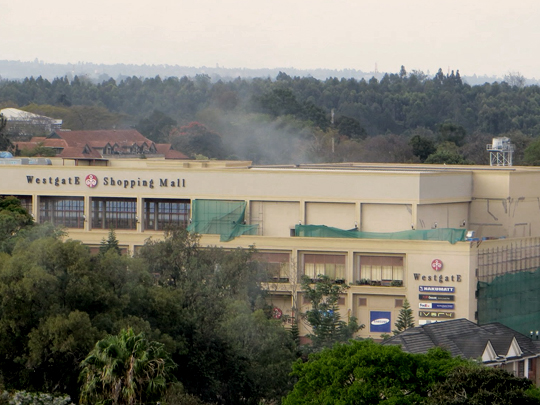
At around midday on 21 September 2013, four masked gunmen attacked the Westgate shopping mall, an upscale mall in Nairobi, Kenya.
Cameras in the mall revealed the gunmen carried assault rifles and wore civilian clothing. There were also a number of grenade explosions as the attack began.
A number of children were among the victims, while mall security guards managed to use shopping carts to get out wounded children, with many people escaping via a back entrance.
The attack lasted several hours, with the last victim killed before special Kenyan security forces entered the mall. The mall was officially declared secured on 24 September.
In total, 71 people were killed, including 62 civilians, 5 Kenyan soldiers, and 4 attackers. An estimated 200 people were wounded in the shooting, while part of the mall also collapsed due to a fire that started during the siege.
The Islamic extremist group al-Shabaab claimed responsibility for the incident, claiming it as retribution for the Kenyan military’s deployment in the group’s home country of Somalia.
In the aftermath of the attack, Kenyan authorities arrested dozens of people. On 4 November 2013, a Kenyan court charged four Somali nationals with harbouring the gunmen in their homes, with each pleading not guilty.
The al-Shabaab member believed to have masterminded the mall attack, Adan Garar, was reported as being killed after a drone strike in March 2015. Gara was in a vehicle hit by a missile in southern Somalia.
6 – A Garment Factory Collapses in Bangladesh Killing Over 1,000 People
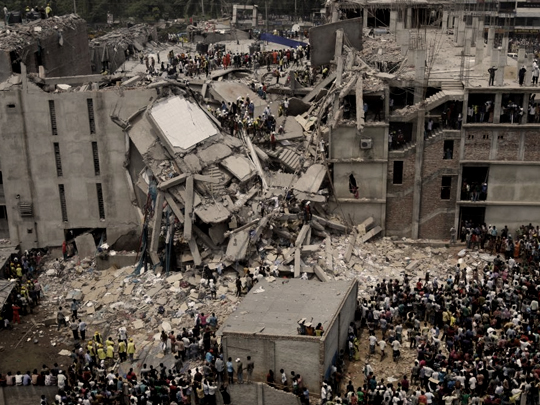
On 24 April 2013, an eight-story commercial building, called Rana Plaza, in the Savar Upazila of Dhaka District, Bangladesh, collapsed.
The factories within the building made clothing for European and American retailers such as JC Penny, Cato Fashions, Benetton, Primark, Prada, Gucci, Versace, and others.
The building contained clothing factories, a bank, apartments, and a number of shops. The shops and the bank on the lower floors were immediately closed after cracks were discovered in the building on 23 April.
However, the building’s owner, Sohel Rana, ignored warnings to avoid using the building, declaring the building was safe.
Garment workers were ordered to return the following day, with managers at Ether Tex threatening to withhold a month’s pay from workers who refused to come to work.
The building collapsed during the following morning during rush-hour, with a confirmed 3,122 workers in the building at the time of the collapse.
Among the reasons for the structural failure was the building being built on a filled-in pond, the addition of three floors above the original permit, and the use of substandard construction material.
When the search for survivors ended on 13 May, there was a death toll of 1,134 people. An estimated 2,500 injured people were rescued from the building alive.
It is considered the deadliest structural failure accident in modern human history and is also the deadliest garment-factory disaster in history.
7 – Pope Benedict XVI Becomes the First Pope to Retire Since 1415 & is Succeeded by Pope Francis

The resignation of Pope Benedict XVI occurred on 28 February 2013, having previously announced his decision on the morning of 11 February 2013 by himself.
Benedict XVI became the first pope to relinquish his position as leader of the Catholic Church since Gregory XII in 1415, and the first to do so of his own volition since Celestine V in 1294.
Gregory XII had resigned in order to end Western Schism, which was a period of time between 1378 and 1417 when more than one person claimed to be the true pope.
The move was unexpected, as popes have generally held the position from election until death.
Benedict stated the reason for his decision was his declining health due to old age (he was 85 at the time).
The conclave to select his successor began on 12 March 2013 and elected Cardinal Jorge Mario Bergoglio, Archbishop of Buenos Aires, Argentina, who took the name of Francis.


